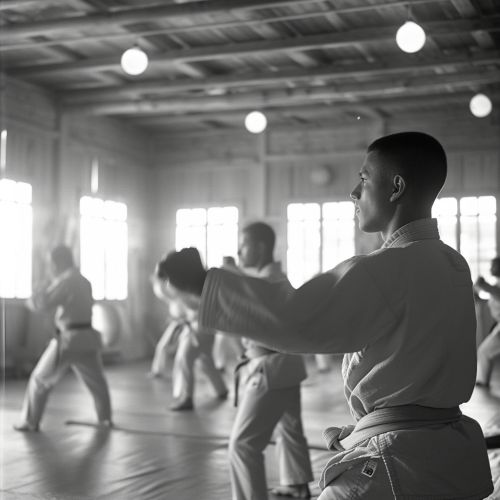Karate
History
Karate, a martial art developed in the Ryukyu Kingdom, is a blend of indigenous Ryukyuan martial arts and Chinese kenpō. The Ryukyu Kingdom was an independent kingdom that ruled most of the Ryukyu Islands from the 15th to the 19th century. The Ryukyu martial arts, known as te (手, literally "hand"), became more specialized during the kingdom's "Golden Age of Trade" with Southeast and East Asia.


The term "karate" was first used in the early 20th century as a blanket term to describe all martial arts originating from Okinawa. The word "karate" is a combination of two Japanese characters: kara (空), meaning empty, and te (手), meaning hand; thus, karate means "empty hand."
Techniques
Karate techniques are divided into three parts: kata (forms), kumite (sparring), and kion (basics). Each part is essential to the overall training and development of a Karate practitioner, known as a karateka.
Kata
Kata are detailed choreographed patterns of movements practiced either solo or in pairs. Each kata has a fixed number of movements, which must be executed in a certain order. The movements in kata represent various offensive and defensive postures, drawn from the application of techniques.
Kumite
Kumite is the part of karate in which a person trains against an adversary, using the techniques learned from the kata. Kumite can be used to develop a particular technique or a skill (such as timing or speed), or it can be done in competition.
Kion
Kion is a type of exercise consisting of a fixed set of movements. Kion is not as elaborate as kata but is used to teach students the basic movements of karate.
Styles
There are many styles of karate, each with its unique aspects, but most can be grouped into one of two types: traditional and sport. Traditional karate places emphasis on self-development, while sport karate focuses on exercise and competition.
Traditional Karate
Traditional karate emphasizes self-development (budo). Its training is quite formal and strict, with a focus on etiquette and discipline. The main traditional styles include Shotokan, Goju-Ryu, Shito-Ryu, and Wado-Ryu.
Sport Karate
Sport karate places emphasis on exercise, competition, and winning medals. The main sport styles include point karate and full contact karate. Point karate has fast, light contact strikes and kicks that are scored by a referee. Full contact karate has strikes and kicks that knock out the opponent.
Philosophy
Karate is not just a system of combat; it is also a way of life that seeks to improve character, build human spirit, and train for serenity and peace. The philosophy of karate is deeply rooted in the ancient Japanese warrior culture and the teachings of Zen Buddhism.
Training
Karate training is commonly divided into kion, kata, and kumite activities. Training may also include a comprehensive health and fitness regimen, usually conditioning exercises, such as push-ups and squats, and flexibility exercises, such as stretching. It is recommended that karate should be practiced regularly in a dojo, or training hall, under the guidance of a qualified instructor.

